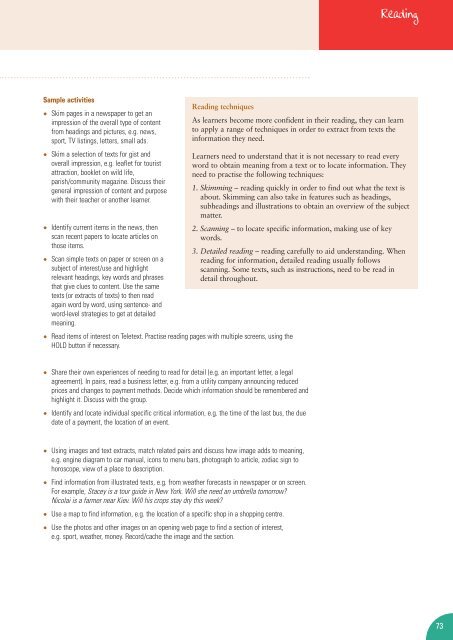Adult Literacy Core Curriculum - Nationally developed Skills for Life ...
Adult Literacy Core Curriculum - Nationally developed Skills for Life ...
Adult Literacy Core Curriculum - Nationally developed Skills for Life ...
You also want an ePaper? Increase the reach of your titles
YUMPU automatically turns print PDFs into web optimized ePapers that Google loves.
Sample activities<br />
• Skim pages in a newspaper to get an<br />
impression of the overall type of content<br />
from headings and pictures, e.g. news,<br />
sport, TV listings, letters, small ads.<br />
• Skim a selection of texts <strong>for</strong> gist and<br />
overall impression, e.g. leaflet <strong>for</strong> tourist<br />
attraction, booklet on wild life,<br />
parish/community magazine. Discuss their<br />
general impression of content and purpose<br />
with their teacher or another learner.<br />
• Identify current items in the news, then<br />
scan recent papers to locate articles on<br />
those items.<br />
• Scan simple texts on paper or screen on a<br />
subject of interest/use and highlight<br />
relevant headings, key words and phrases<br />
that give clues to content. Use the same<br />
texts (or extracts of texts) to then read<br />
again word by word, using sentence- and<br />
word-level strategies to get at detailed<br />
meaning.<br />
• Read items of interest on Teletext. Practise reading pages with multiple screens, using the<br />
HOLD button if necessary.<br />
• Share their own experiences of needing to read <strong>for</strong> detail (e.g. an important letter, a legal<br />
agreement). In pairs, read a business letter, e.g. from a utility company announcing reduced<br />
prices and changes to payment methods. Decide which in<strong>for</strong>mation should be remembered and<br />
highlight it. Discuss with the group.<br />
• Identify and locate individual specific critical in<strong>for</strong>mation, e.g. the time of the last bus, the due<br />
date of a payment, the location of an event.<br />
• Using images and text extracts, match related pairs and discuss how image adds to meaning,<br />
e.g. engine diagram to car manual, icons to menu bars, photograph to article, zodiac sign to<br />
horoscope, view of a place to description.<br />
• Find in<strong>for</strong>mation from illustrated texts, e.g. from weather <strong>for</strong>ecasts in newspaper or on screen.<br />
For example, Stacey is a tour guide in New York. Will she need an umbrella tomorrow?<br />
Nicolai is a farmer near Kiev. Will his crops stay dry this week?<br />
• Use a map to find in<strong>for</strong>mation, e.g. the location of a specific shop in a shopping centre.<br />
• Use the photos and other images on an opening web page to find a section of interest,<br />
e.g. sport, weather, money. Record/cache the image and the section.<br />
Reading<br />
Reading techniques<br />
As learners become more confident in their reading, they can learn<br />
to apply a range of techniques in order to extract from texts the<br />
in<strong>for</strong>mation they need.<br />
Learners need to understand that it is not necessary to read every<br />
word to obtain meaning from a text or to locate in<strong>for</strong>mation. They<br />
need to practise the following techniques:<br />
1. Skimming – reading quickly in order to find out what the text is<br />
about. Skimming can also take in features such as headings,<br />
subheadings and illustrations to obtain an overview of the subject<br />
matter.<br />
2. Scanning – to locate specific in<strong>for</strong>mation, making use of key<br />
words.<br />
3. Detailed reading – reading carefully to aid understanding. When<br />
reading <strong>for</strong> in<strong>for</strong>mation, detailed reading usually follows<br />
scanning. Some texts, such as instructions, need to be read in<br />
detail throughout.<br />
73

















